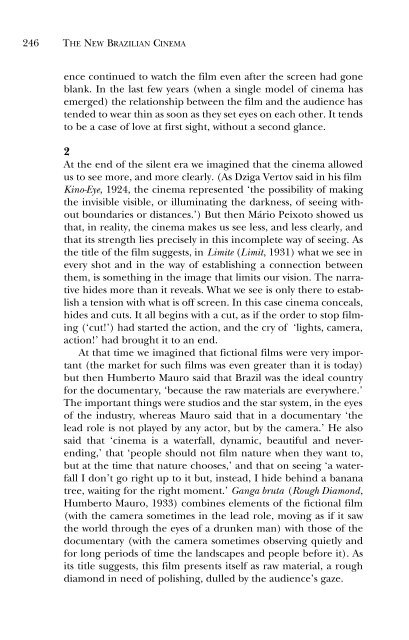Sertão
Sertão
Sertão
Create successful ePaper yourself
Turn your PDF publications into a flip-book with our unique Google optimized e-Paper software.
246<br />
THE NEW BRAZILIAN CINEMA<br />
ence continued to watch the film even after the screen had gone<br />
blank. In the last few years (when a single model of cinema has<br />
emerged) the relationship between the film and the audience has<br />
tended to wear thin as soon as they set eyes on each other. It tends<br />
to be a case of love at first sight, without a second glance.<br />
2<br />
At the end of the silent era we imagined that the cinema allowed<br />
us to see more, and more clearly. (As Dziga Vertov said in his film<br />
Kino-Eye, 1924, the cinema represented ‘the possibility of making<br />
the invisible visible, or illuminating the darkness, of seeing without<br />
boundaries or distances.’) But then Mário Peixoto showed us<br />
that, in reality, the cinema makes us see less, and less clearly, and<br />
that its strength lies precisely in this incomplete way of seeing. As<br />
the title of the film suggests, in Limite (Limit, 1931) what we see in<br />
every shot and in the way of establishing a connection between<br />
them, is something in the image that limits our vision. The narrative<br />
hides more than it reveals. What we see is only there to establish<br />
a tension with what is off screen. In this case cinema conceals,<br />
hides and cuts. It all begins with a cut, as if the order to stop filming<br />
(‘cut!’) had started the action, and the cry of ‘lights, camera,<br />
action!’ had brought it to an end.<br />
At that time we imagined that fictional films were very important<br />
(the market for such films was even greater than it is today)<br />
but then Humberto Mauro said that Brazil was the ideal country<br />
for the documentary, ‘because the raw materials are everywhere.’<br />
The important things were studios and the star system, in the eyes<br />
of the industry, whereas Mauro said that in a documentary ‘the<br />
lead role is not played by any actor, but by the camera.’ He also<br />
said that ‘cinema is a waterfall, dynamic, beautiful and neverending,’<br />
that ‘people should not film nature when they want to,<br />
but at the time that nature chooses,’ and that on seeing ‘a waterfall<br />
I don’t go right up to it but, instead, I hide behind a banana<br />
tree, waiting for the right moment.’ Ganga bruta (Rough Diamond,<br />
Humberto Mauro, 1933) combines elements of the fictional film<br />
(with the camera sometimes in the lead role, moving as if it saw<br />
the world through the eyes of a drunken man) with those of the<br />
documentary (with the camera sometimes observing quietly and<br />
for long periods of time the landscapes and people before it). As<br />
its title suggests, this film presents itself as raw material, a rough<br />
diamond in need of polishing, dulled by the audience’s gaze.
















